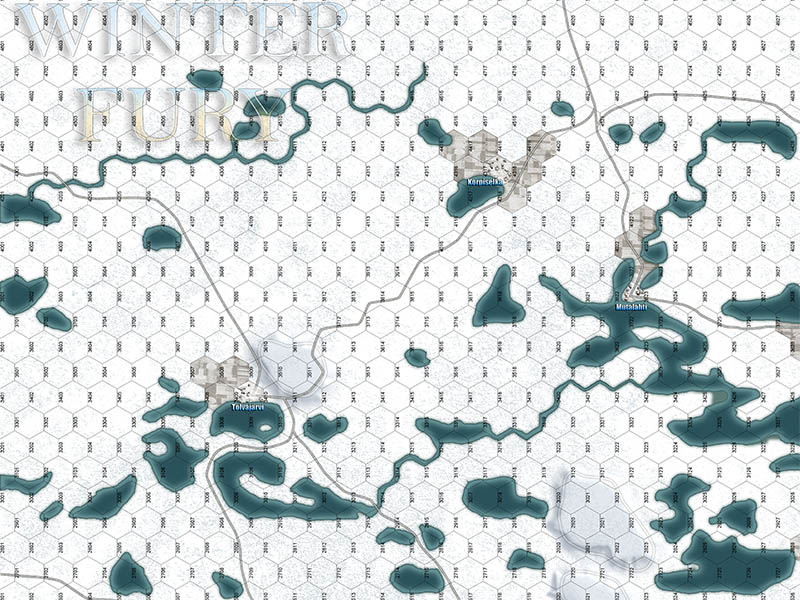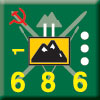| Winter Fury:
Publisher’s Preview
By Mike Bennighof, Ph.D.
November 2024
 I have a number of obsessions, most of which I probably shouldn’t mention on a website open to the public (thankfully, none of them involve lewd acts while dressed as an equine). I’ve always had a very strong interest in Finland’s role in the Second World War, and designed many games on Finno-centric topics (ten I think, but it depends on how and what you’re counting). I have a number of obsessions, most of which I probably shouldn’t mention on a website open to the public (thankfully, none of them involve lewd acts while dressed as an equine). I’ve always had a very strong interest in Finland’s role in the Second World War, and designed many games on Finno-centric topics (ten I think, but it depends on how and what you’re counting).
One of those, Winter Fury, is based on the Battle of Tolvajärvi in December 1939. The battle itself took place during the early days of the Winter War. Soviet troops invaded Finland north of Lake Ladoga, unexpectedly pushing into a sparsely-populated region and threatening the northern flank of the Finnish positions on the big lake’s northern shore. A scratch Finnish force totaling about a brigade’s worth of troops destroyed one Soviet rifle division and mauled a second one.
The game covers the Tolvajärvi battle, including the Soviet probe at Ilomantsi slightly to the north. The Finns start with just two infantry battalions plus a few companies against three Soviet rifle divisions plus a supporting tank brigade. The Finnish objective is to slow the Soviet advance on the town of Tolvajärvi, and then stop them once reinforcements arrive.
Along with the game on the 1939 battles, we’ve also included additional pieces and a scenario to fight out the 1941 Finnish offensive over this same ground. While the new Winter Fury includes a map with brand-new artwork, the map doesn’t quite cover enough of the area to include the 1944 battles.

Winter Fury comes in our Playbook format, with a map, pieces and a book instead of a standard box. The book includes the game rules as well as some strategy hints and historical background on the battles, the armies involved and the Winter War.
 The game uses a system we introduced with our very first game release back in 1994, MacArthur’s Return. The weather determines the number of impulses players can conduct each turn. Each player puts a number of activation chits in a common container, but the number of chits that go in the container each turn is far more than the number that will be drawn. The game uses a system we introduced with our very first game release back in 1994, MacArthur’s Return. The weather determines the number of impulses players can conduct each turn. Each player puts a number of activation chits in a common container, but the number of chits that go in the container each turn is far more than the number that will be drawn.
Each time a Finnish chit is drawn, the Finnish player can perform the specified action (Full, Move, Attack, Choice or Half) with all the Finnish units on the board. Soviet chits are specific to each Soviet division, so when a Soviet chit comes up the Soviet player can perform the specified action only with units from the division noted on the chit. This gives the Finns enormous flexibility relative to the Soviets, letting them move several times per turn to attack the Soviets at their weakest points or ski behind the Red Army to cut off their supply lines.
Daily Content includes no AI-generated content or third-party ads. We work hard to keep it that way, and that’s a lot of work. You can help us keep things that way with your gift through this link right here.
 “Full” chits allow the player to move and fight with all the units designated by the chit, while “Move” and “Attack” chits let the designated units only move or attack. “Choice” lets the player choose whether to move or attack, while “Half” chits let the designated units either move at half speed or have a 50-50 chance of attacking. “Full” chits allow the player to move and fight with all the units designated by the chit, while “Move” and “Attack” chits let the designated units only move or attack. “Choice” lets the player choose whether to move or attack, while “Half” chits let the designated units either move at half speed or have a 50-50 chance of attacking.
The Finns have a much better selection: there are no Finnish Move or Attack chits. Every time a Finnish chit is pulled the Finnish player will get to move or attack (sometimes he or she will have to choose, and sometimes it will only be a “Half” chit). The Soviets must bring all their firepower to bear each time they attack a Finnish position and must be careful to mount strong rearguards to protect their supply lines from Finnish ski companies.
Almost all Finnish units are ski-capable, meaning they can move quickly through most terrain. The Soviets have only a few ski units, and most of their units can make progress only when moving along the handful of roads.
 Most of the board is covered by highly-defensible forest. The number of units that can attack a hex (from each adjacent hex) is limited to the number of units that could actually enter it, and in most cases, only two units can enter a forest hex. If the Finns block a road hex by stacking one or two strong units there, the Soviets must work hard to maneuver their most powerful units to attack and inflict losses without taking greater losses themselves. On the other hand, the Soviets have a great deal of artillery, which is more effective the more targets are stacked in a hex together. Most of the board is covered by highly-defensible forest. The number of units that can attack a hex (from each adjacent hex) is limited to the number of units that could actually enter it, and in most cases, only two units can enter a forest hex. If the Finns block a road hex by stacking one or two strong units there, the Soviets must work hard to maneuver their most powerful units to attack and inflict losses without taking greater losses themselves. On the other hand, the Soviets have a great deal of artillery, which is more effective the more targets are stacked in a hex together.
Finnish ski troops can also attempt to retreat before combat when attacked in forest terrain (as long as they have an escape route available). Retreating allows the Soviets to advance into the vacated hex, but if the Finns ski around the Soviets to harass their flanks and rear, then the Soviets have no incentive to follow them off the road and away from their objectives.
 The Finns can trace long supply lines to any of several towns on the board, or any Finnish headquarters. The only Soviet supply sources are two road hexes on the southern board edge. The Soviets can’t afford to leave the roads behind them unguarded, else Finnish ski companies will block the supply lines of entire divisions with ease. All unsupplied units have their attack strength halved, unsupplied artillery can’t fire at all, and unsupplied Soviet units have their defense strength halved and their movement allowance reduced by one. The Finns can trace long supply lines to any of several towns on the board, or any Finnish headquarters. The only Soviet supply sources are two road hexes on the southern board edge. The Soviets can’t afford to leave the roads behind them unguarded, else Finnish ski companies will block the supply lines of entire divisions with ease. All unsupplied units have their attack strength halved, unsupplied artillery can’t fire at all, and unsupplied Soviet units have their defense strength halved and their movement allowance reduced by one.
The Finns can also build forts to double their defense strength, construct secret ice roads to allow them to move quickly through the trackless forests, and break down their battalions into their component companies to enable flanking attacks and assaults on Soviet supply lines. Plus, Finnish units which eliminate Soviet tank and anti-tank companies can capture the Soviet equipment and create their own tank and anti-tank units.
 The Soviets counter all this with firepower. Enormous firepower. The Finns have only light artillery and no air power, while the Soviets have plenty of both. Soviet artillery and aircraft can bombard Finnish positions in advance of ground attacks or support the infantry directly. And they have tanks: the Finns fear tanks (though not much else) and may run away in a blind Panssari Panic when facing them without anti-tank guns of their own. The Soviets counter all this with firepower. Enormous firepower. The Finns have only light artillery and no air power, while the Soviets have plenty of both. Soviet artillery and aircraft can bombard Finnish positions in advance of ground attacks or support the infantry directly. And they have tanks: the Finns fear tanks (though not much else) and may run away in a blind Panssari Panic when facing them without anti-tank guns of their own.
It’s a fun game in a fun game system, a system I’d like to use in more games.
Click here to order Winter Fury right now.
Sign up for our newsletter right here. Your info will never be sold or transferred; we'll just use it to update you on new games and new offers.
Mike Bennighof is president of Avalanche Press and holds a doctorate in history from Emory University. A Fulbright Scholar and NASA Journalist in Space finalist, he has published a great many books, games and articles on historical subjects; people are saying that some of them are actually good.
He lives in Birmingham, Alabama with his wife and three children. He will never forget his Iron Dog, Leopold. Leopold feared and hated bicycles.
Daily Content includes no AI-generated content or third-party ads. We work hard to keep it that way, and that’s a lot of work. You can help us keep things that way with your gift through this link right here.
|
